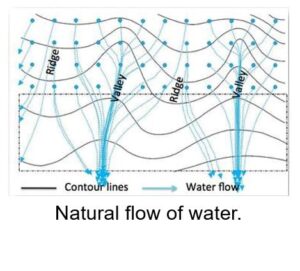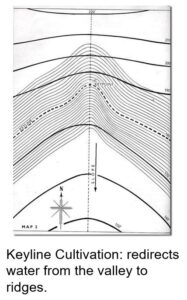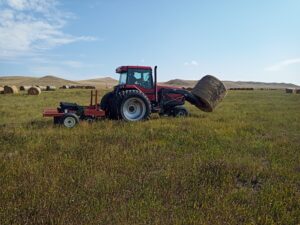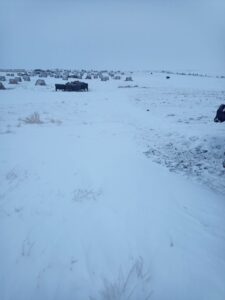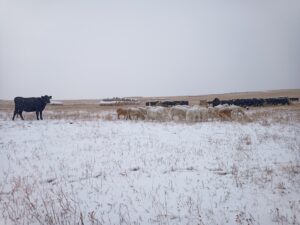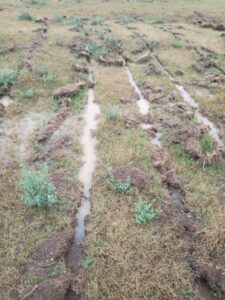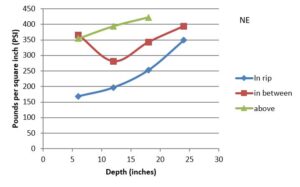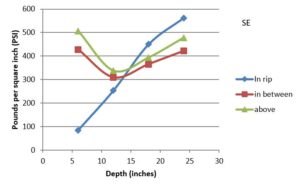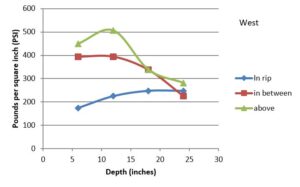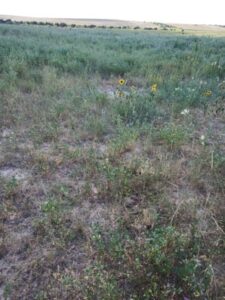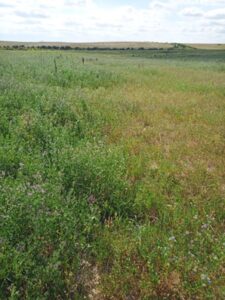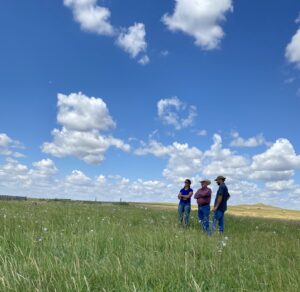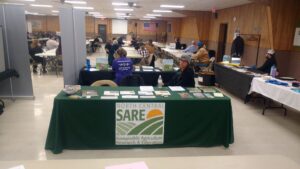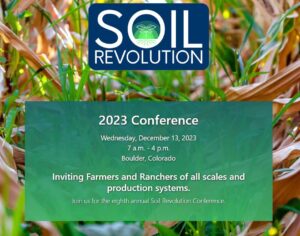Final report for FNC22-1326
Project Information
For over ten years, Drew worked in the oil industry where he became a proficient mechanical engineer. By working in an outside industry, he found and created opportunities to become involved with farming and ranching on a full-time basis. He now manages a cow-calf and sheep operation along with 970 acres of native, 270 acres of improved pasture, and 240 acres of winter forage/hayland. Unfortunately, much of his land was abused prior to his management. Farming practices and severe over grazing left the soil to erode by wind and water. He has worked with NRCS, USFWS, ND State Water Commission and others to transition from a 3-cell pasture rotation relying on dugouts for water to a 28-cell rotation with miles of pipeline, multiple wells (solar and conventional), dams for wildlife, cover crops for pollinators and soil health, and miles of trees. Wetland acres are being intensively managed through mob grazing with sheep. He continues to work closely with conservation groups to address resource concerns and make long-term improvements in an effort to revitalize the land and improve wildlife habitat.
I have spent the last several years working off the farm to advance my knowledge of production agriculture and have now transitioned back to the farm and ranch on a full-time basis. Every position of employment has contributed to my overall understanding of natural resource management. I have also earned a M.S. and Ph. D. in Range Science which helps me to design experiments, but also interpret and integrate research from multiple disciplines. I operate with both sheep and cattle and manage 720 acres of crop and hayland. I have previously worked with NRCS and USFWS to build soil health by managing some of the land as a cover crop for pollinators which will ultimately be converted to a perennial system.
This project addresses resource concerns of land that was conventionally farmed and depleted. Though bale grazing has created environmental and economic benefits, water management continues to be a challenge. To accelerate the benefits of bale grazing, it was chosen to implement and demonstrate a practice that transforms water management.
Keyline design was developed in the 1950s to address dwindling water supplies and soil erosion. The central idea from a water perspective is to capture water at the highest elevation and comb it out towards the ridges. The Keyline cultivator is a narrow tyne plow that loosens the sub-soil without inversion, transporting organic matter, from bale grazing and manure deposits, deeper into the soil. Water, air and organic matter feed microbiota which promotes carbon sequestration.
Stored carbon is essential to agriculture and society, though CO2 is regarded as a greenhouse gas and a waste. Historic and conventional practices limit carbon sequestration, but with proper management, the ecosystem can store more carbon than man-made infrastructure. Carbon storage benefits society and creates opportunities in the marketplace. We hope the combined effect of bale grazing and Keyline cultivation is storing carbon deeper into the soil profile, while accelerating healing and increasing forage production.
- Evaluate the usefulness of bale grazing and Keyline cultivation to improve carbon sequestration and increase market opportunities for producers.
- Improve water management and reduce runoff through Keyline pattern cultivation.
- Monitor the impact of bale grazing and Keyline cultivation to improve forage production.
- Share findings to improve understanding of the carbon cycle and to demonstrate a producer-led means of carbon storage.
Cooperators
- (Educator)
- (Educator)
Research
Multi-species bale grazing and Keyline cultivation was planned to occur across 160 acres of land that had been historically mismanaged to a point of soil depletion. Bale grazing is a winter-feeding strategy that provides both environmental and economic benefits. Keyline cultivation is a subsoil method that uses the concept of Keyline geometry. It is meant to penetrate the subsoil, to a depth of 2" below existing rooting depth without inverting the soil. The objective is to direct the shallow overland flow, which results from rainfall or spring runoff, to remain evenly spread (e.g. hillsides and ridges) and not follow its natural flow path to concentrate in the valley.
Through water movement, hoof action, light harrowing and other natural processes, it is hopeful that manure and residue from bale grazing will be deposited into Keylines. As a result, organic matter will fall into contact with the subsoil and evapotranspiration of nutrients will be reduced due to shading and cooler temperatures. Through this management, microbial populations will be provided with water, food and air which promotes carbon sequestration.
To get the project started, we met with extension educators and project collaborators during the spring of 2022. Through this meeting, a timeline was developed and plans were made for the team to meet again in the spring of 2023. Throughout the project period, project coordinators will make arrangements with team members to coordinate on project activities and/or outreach efforts. As data is collected, follow-up meetings may be organized to review and interpret information.
Baseline soil samples were collected during the spring of 2022 to assess soil nutrient and microbial activity (Haney Soil Test) prior to bale grazing and Keyline cultivation. Soil samples will be collected on an annual basis to monitor change over time. Samples will also be collected at varying depths and distances from the Keyline to monitor the scale of impact.
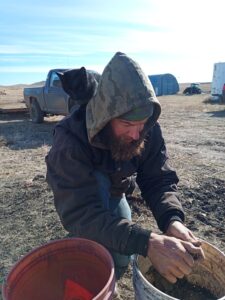
During the summer of 2022 and 2023, hay was harvested on the project site and across other hayland acres to be able to carry out bale grazing each fall and winter. Forage production was monitored within the project area and comparisons were made to other management strategies.
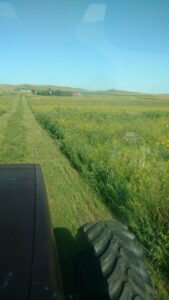
Surveying equipment and flags were used to designate placement of Keyline cultivation as indicated on the map. Lines were successfully cultivated in the fall of 2022.
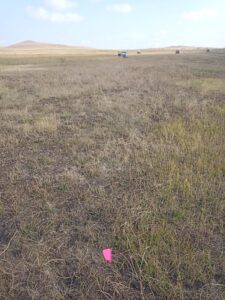
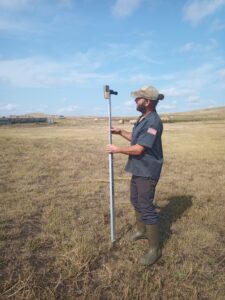
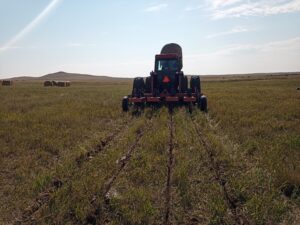
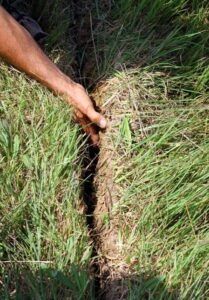
video-c51e1377-70a4-44dd-bd7c-dfb7881e9521-1671215286
video-e2014552-59ad-480a-b9f4-a1c4756a2047-1671215290
Following moisture events, observations were made both above and below the Keyline cultivated areas to note any changes in sheet or rill erosion. Soil moisture and compaction was measured at varying depths and distances from the Keyline to monitor the scale of impact.
Additional hay was hauled to the project area in fall of 2022 to support approximately 300 cows, 40 ewes and 15 ewe lambs. During 2023, approximately 75 bred heifers, 50 ewes, and 27 ewe lambs bale grazed in the project area. Portable windbreak panels were set up to provide wind protection to multiple species. Bales were distributed and temporary fences for bale grazing rotations were installed during the early winter months. Livestock body condition was scored before, during, and after bale grazing to monitor relative fatness. Supplemental feed was made available to sheep to maintain adequate nutrition. Multi-species bale grazing occurred from December 12 to May 30, 2022. During 2023, multi-species bale grazing began on November 30th.
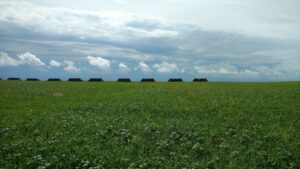
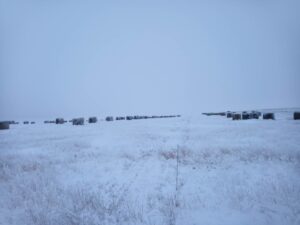
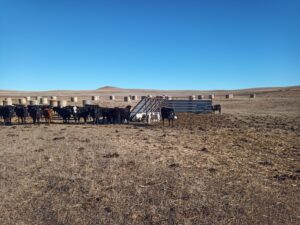
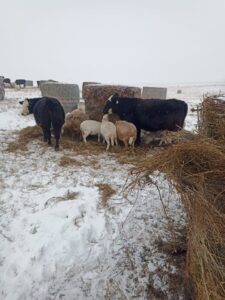
It is important to review climate conditions because variables like temperature and precipitation can influence a number of the parameters measured within this project. Hayfields and pastures were moderately productive in 2022; however, drought conditions returned in early July. The winter started seemingly mild, but a series of blizzards occurred in December/January and April.
Hayfields and pastures were quite productive in 2023. The winter was mild with minimal snowfall and above normal temperatures in December. However, a prolonged cold spell occurred in January.
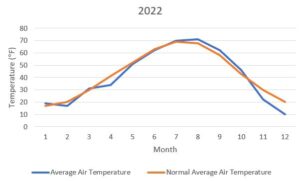
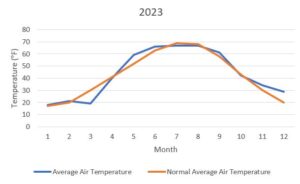
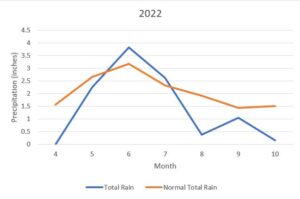
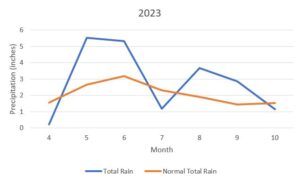
Baseline soil samples were collected during the spring of 2022 to assess soil nutrient and microbial activity (Haney Soil Test) prior to bale grazing and Keyline cultivation, see tables below. Soil samples were also collected in the spring of 2023 and 2024 to monitor changes over time. Samples were collected at varying depths to monitor the scale of impact. We were particularly interested to see if we could influence subsoil nutrient and microbial activity through the use of Keyline cultivation and bale grazing.
| Keyline & Bale Graze - Replicate 1 | ||||||
| Spring 2022 | Spring 2023 | Spring 2024 | Spring 2022 | Spring 2023 | Spring 2024 | |
| 0-6" | 0-6" | 0-6" | 6-24" | 6-24" | 6-24" | |
| pH | 7.3 | 7.2 | 6.9 | 8.5 | 7.4 | 7.7 |
| Soluble salts, mmha/cm | 0.19 | 0.24 | 0.11 | 0.15 | 0.22 | 0.15 |
| Excess Lime | NONE | NONE | NONE | HIGH | NONE | LOW |
| OM, % | 3.3 | 3.5 | 2.5 | 2.2 | 2.3 | 1.6 |
| Soil Respiration, CO2-C, ppm C | 49.6 | 56.8 | 101.0 | 12.3 | 26.4 | 50.0 |
| Total N, ppm | 15.8 | 35.5 | 18.1 | 5.0 | 18.6 | 9.8 |
| Organic N, ppm | 11.7 | 25.9 | 10.7 | 3.6 | 12.2 | 5.5 |
| Total Organic C, ppm | 139 | 195 | 181 | 62 | 143 | 106 |
| Total P, ppm | 5 | 9 | 5 | 1 | 14 | 2 |
| K, ppm | 135 | 479 | 419 | 43 | 236 | 183 |
| Zn, ppm | 0.14 | 0.40 | 0.31 | 0.01 | 0.32 | 0.18 |
| Fe, ppm | 34 | 10.8 | 16.0 | 5 | 14.4 | 8.9 |
| Mn, ppm | 3.0 | 5.9 | 9.2 | 0.2 | 6.5 | 2.8 |
| Cu, ppm | 0.08 | 0.46 | 0.70 | 0.05 | 0.99 | 0.96 |
| Microbially Active Carbon, % | 35.8 | 29.1 | 56.0 | 19.9 | 18.5 | 47.4 |
| Organic C: Organic N | 11.8 | 7.6 | 16.9 | 17.2 | 11.7 | 19.3 |
| Organic N Release, ppm | 11.7 | 25.9 | 10.7 | 2.9 | 9.0 | 5.5 |
| Organic N Reserve, ppm | 0.0 | 0.0 | 0.0 | 0.7 | 3.2 | 0.0 |
| Soil Health Calculation | 8.91 | 12.71 | 14.76 | 2.83 | 7.17 | 8.21 |
| Keyline & Bale Graze - Replicate 2 | ||||||
| Spring 2022 | Spring 2023 | Spring 2024 | Spring 2022 | Spring 2023 | Spring 2024 | |
| 0-6" | 0-6" | 0-6" | 6-24" | 6-24" | 6-24" | |
| pH | 7.3 | 7 | 6.8 | 7.7 | 7.6 | 7.5 |
| Soluble salts, mmha/cm | 0.28 | 0.29 | 0.16 | 0.8 | 0.19 | 0.13 |
| Excess Lime | NONE | NONE | NONE | HIGH | NONE | LOW |
| OM, % | 3.5 | 2.9 | 2.4 | 2.7 | 2.6 | 1.9 |
| Soil Respiration, CO2-C, ppm C | 74.6 | 31.4 | 96 | 25.1 | 15.3 | 53 |
| Total N, ppm | 23.2 | 45.6 | 28.7 | 5.7 | 20.6 | 16 |
| Organic N, ppm | 14.7 | 26.5 | 15.8 | 3.3 | 9.4 | 6.3 |
| Total Organic C, ppm | 133 | 163 | 177 | 53 | 114 | 101 |
| Total P, ppm | 6 | 13 | 7 | 2 | 10 | 5 |
| K, ppm | 129 | 384 | 335 | 42 | 101 | 194 |
| Zn, ppm | 0.23 | 0.43 | 0.54 | 0.03 | 0.2 | 0.32 |
| Fe, ppm | 31 | 16.4 | 20.1 | 7 | 7.7 | 10.3 |
| Mn, ppm | 4.5 | 9.7 | 10.2 | 0.3 | 7 | 4.3 |
| Cu, ppm | 0.06 | 0.55 | 0.53 | 0.06 | 0.29 | 0.75 |
| Microbially Active Carbon, % | 56 | 19.3 | 54.3 | 46.9 | 13.4 | 52.6 |
| Organic C: Organic N | 9.1 | 6.1 | 11.2 | 16.4 | 12.2 | 16 |
| Organic N Release, ppm | 14.7 | 20.4 | 15.8 | 3.3 | 5 | 6.3 |
| Organic N Reserve, ppm | 0 | 6.1 | 0 | 0 | 4.3 | 0 |
| Soil Health Calculation | 11.6 | 9.55 | 14.79 | 3.91 | 5.06 | 8.49 |
| Keyline & Bale Graze - Replicate 3 | ||||||
| Spring 2022 | Spring 2023 | Spring 2024 | Spring 2022 | Spring 2023 | Spring 2024 | |
| 0-6" | 0-6" | 0-6" | 6-24" | 6-24" | 6-24" | |
| pH | 7.2 | 6.2 | 6.8 | 8.2 | 6.8 | 7.2 |
| Soluble salts, mmha/cm | 0.18 | 0.15 | 0.17 | 0.3 | 0.15 | 0.22 |
| Excess Lime | NONE | NONE | NONE | HIGH | NONE | NONE |
| OM, % | 3.2 | 3.3 | 2.7 | 1.7 | 2.1 | 1.6 |
| Soil Respiration, CO2-C, ppm C | 61 | 42.5 | 116 | 16.5 | 25.6 | 46 |
| Total N, ppm | 18.1 | 17.4 | 30.9 | 9.4 | 9.8 | 37.3 |
| Organic N, ppm | 12.4 | 13.2 | 19.1 | 6.1 | 8.5 | 17.9 |
| Total Organic C, ppm | 131 | 146 | 251 | 82 | 106 | 144 |
| Total P, ppm | 9 | 56 | 34 | 1 | 20 | 9 |
| K, ppm | 300 | 311 | 871 | 30 | 224 | 329 |
| Zn, ppm | 0.46 | 1.04 | 1.4 | 0.11 | 0.22 | 0.7 |
| Fe, ppm | 68 | 37.7 | 47.9 | 10 | 12.7 | 17.2 |
| Mn, ppm | 6.5 | 11.6 | 38.9 | 0.5 | 7.6 | 10.4 |
| Cu, ppm | 0.14 | 0.38 | 0.59 | 0.13 | 0.25 | 0.57 |
| Microbially Active Carbon, % | 46.5 | 29 | 46.3 | 20.1 | 24.1 | 31.9 |
| Organic C: Organic N | 10.6 | 11.1 | 13.1 | 13.4 | 12.5 | 8.1 |
| Organic N Release, ppm | 12.4 | 13.2 | 19.1 | 4.9 | 8.2 | 17.9 |
| Organic N Reserve, ppm | 0 | 0 | 0 | 1.2 | 0.3 | 0 |
| Soil Health Calculation | 9.96 | 9.05 | 18.16 | 3.9 | 5.98 | 9.83 |
Data associated with soluble salts was variable across replicates. Excess lime at 0-6” was minimal during all years of the study. At 6-24”, excess lime was high during 2022 but changed to none or low by 2024. % OM had a neutral or positive response to Keyline cultivation and bale grazing from 2022 to 2023, but reduced from 2023 to 2024. While we expected to see this number continue to increase in 2024, added residue may need additional time to be broken down by soil microbes.
Soil respiration is a test aimed at measuring the amount of CO2-C a soil can produce over a 24 hour incubation period following a significant drying and rewetting event. Most microbes produce CO2 through aerobic respiration and the more CO2 a soil produces the more life it contains or the higher the microbial biomass. Soil respiration readings can fall anywhere from near zero to 1000 ppm of CO2-C. However, most agricultural soils are currently degraded and do not read above 200 ppm. In general, the higher the number the better. Soil respiration was variable across replicates in 2022 and 2023, but ranged from slightly below average to above average at 0-6" and low to below average at 6-24". Soil respiration was classified as above average or high at 0-6" and slightly below or above average at 6-24" in 2024. It is important to note that climate conditions at the time of sampling are likely to influence these results.
Below is a table created by Ward Laboratories used to interpret CO2-C measurements.
|
CO2-C, ppm |
Ranking |
Implications |
|
0-10 |
Very low |
Very little potential for microbial activity; slow nutrient cycling and residue decomposition; high carbon residue may last >2-3 yrs. with limited moisture; Nearly no N credit given; Additional N may be required due to microbial immobilization |
|
11-20 |
Low |
Minimal potential for nutrient cycling; residue management can still be a problem; Very little to no N credit given |
|
21-30 |
Below average |
Some potential for nutrient cycling; residue management can still be a problem with prolonged use of high carbon crops; Little N credit given |
|
31-50 |
Slightly below average |
Low to moderate potential for microbial activity; Some N credit may be given |
|
51-70 |
Slightly above average |
Moderate potential for microbial activity; Moderate N credit may be given; May be able to start reducing some N fertilizer application |
|
71-100 |
Above average |
Good potential for microbial activity; Moderate N credit may be given depending on size of organic N pool; Can typically reduce N application rates |
|
101-200 |
High |
High potential for microbial activity; more carbon inputs may be needed to sustain microbial biomass; moderate to high N credit from available organic N pools may be given; N fertilizer reduction can be substantial |
|
>200 |
Very high |
High to very high potential for microbial activity; residue decomposition may be <1 yr.; keeping the soil covered could be a problem in some systems; high potential for N mineralization and N credits from available organic N pools may be given; N fertilizer reduction can be substantial |
N, C, P, K, and Zn positively responded to Keyline cultivation and bale grazing at 0-6” and 6-24”.
% microbially active C is how much of the C pool was acted upon by the microbes. If this value is below 25%, carbon is probably not the factor limiting your soil respiration. Ward Laboratories suggests that perhaps it is the soil’s overall fertility, prolonged cold temps or drought that is limiting microbial biomass. If the value is above 80% this suggests that C could become limiting to microbial respiration soon and your management focus should be on introducing more carbon into the system. The values from 2022 to 2023 declined and is likely due to prolonged cold temps during the spring of 2023. However, the values from 2023 to 2024 increased or were similar to baseline levels.
The soil health score is a summary of the soil respiration, C, and N and represents the current health level of your soil. The score can range anywhere from 0 to 50, but most soils do not score higher than 30. In general, the higher the score the better. Ward Laboratories likes to see the score above 7, though this is just a starting point. All samples were above 7 at 0-6”, but dropped below 7 at 6-24”. The general trend is an increase in overall soil health at both 0-6" and 6-24".
We also collected samples in the fall of 2023 to monitor soil nutrient and microbial response to the direct and indirect impact of bale grazing alone, see table below. The direct impact samples were collected underneath a bale that had been bale grazed, whereas the indirect samples were taken from the bale graze area but not directly underneath a bale that had been grazed.
| Bale Graze - Direct Impact | Bale Graze - Indirect Impact | |
| Fall 2023 | ||
| 0-6" | 0-6" | |
| pH | 7.8 | 7.3 |
| Soluble salts, mmha/cm | 0.35 | 0.22 |
| Excess Lime | NONE | HIGH |
| OM, % | 3.8 | 2.7 |
| Soil Respiration, CO2-C, ppm C | 114.8 | 90.6 |
| Total N, ppm | 54.8 | 21 |
| Organic N, ppm | 28.4 | 14.1 |
| Total Organic C, ppm | 203 | 109 |
| Total P, ppm | 9.2 | 4.4 |
| K, ppm | 878 | 141 |
| Zn, ppm | 0.25 | 0.35 |
| Fe, ppm | 4.7 | 4 |
| Mn, ppm | 2.6 | 2.3 |
| Cu, ppm | 0.4 | 0.35 |
| Microbially Active Carbon, % | 56.6 | 83.3 |
| Organic C: Organic N | 7.1 | 7.7 |
| Organic N Release, ppm | 28.4 | 14.1 |
| Organic N Reserve, ppm | 0 | 0 |
| Soil Health Calculation | 18.04 | 12.82 |
The data shows that parameters respond more to the direct impact of bale grazing. The use of more bales or the rotation of bale grazing locations could spread the direct impact of bale grazing.
Additionally, samples were collected from a location that continues to be managed as a hayed perennial, with no Keyline cultivation or bale grazing (see table below). The site is near the project area and has a similar soil type. It has a history of cover cropping (2016-2018) and was planted to a perennial in 2019. Soil samples were collected in the fall of 2019 and 2023.
|
Perennial that is hayed annually, with a cover cropping history ( 2016-2018: cover crop; perennial planting: 2019) |
|||
| Fall 2019 | Fall 2023 | ||
| 0-6" | 0-6" | 6-24" | |
| pH | 7.6 | 7.1 | 7 |
| Soluble salts, mmha/cm | 0.27 | 0.15 | 0.14 |
| Excess Lime | NA | NONE | NONE |
| OM, % | 2.9 | 2.8 | 2.1 |
| Soil Respiration, CO2-C, ppm C | NA | 98.5 | 29.6 |
| Total N, ppm | 4 | 11.5 | 11.6 |
| Organic N, ppm | NA | 7.4 | 8.5 |
| Total Organic C, ppm | NA | 101 | 80 |
| Total P, ppm | 4 | 11 | 22 |
| K, ppm | 201 | 189 | 52 |
| Zn, ppm | 0.5 | 0.4 | 0.11 |
| Fe, ppm | NA | 14.1 | 7.7 |
| Mn, ppm | 25.3 | 8 | 6.7 |
| Cu, ppm | 0.4 | 0.27 | 0.29 |
| Microbially Active Carbon, % | NA | 97.6 | 36.9 |
| Organic C: Organic N | NA | 13.6 | 9.4 |
| Organic N Release, ppm | NA | 7.4 | 8.5 |
| Organic N Reserve, ppm | NA | 0 | 0 |
| Soil Health Calculation | NA | 12.64 | 5.9 |
Overall, the soil nutrient and microbial response to traditional management was very limited. Doing nothing created no results in terms of improving soil nutrients or creating an environment to that promotes soil health.
Following moisture events, observations were made both above and below the Keyline cultivated areas to note changes in sheet or rill erosion, as well as water runoff. The Keylines were very successful at capturing runoff and slowing down or disrupting sheet and rill erosion. After bale grazing occurred, it was observed that organic matter and manure was deposited into the Keyline slits. Following a winter of record snowfall, it was observed during the spring of 2023 that no runoff occurred below the Keylines.
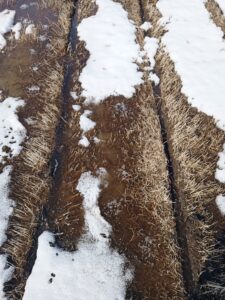
It was intended to use a soil probe to monitor moisture at a depth up to 24" from the base of the Keyline to determine contribution to subsoil moisture. When conditions allowed for the soil probe to be used, soil was at saturated levels. However, when soil was not saturated the probe was not able to penetrate the soil. Therefore, soil moisture levels are not reported.
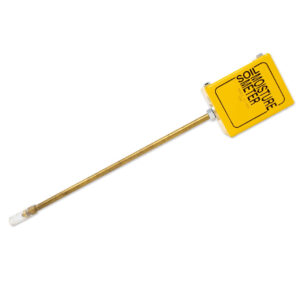
Soil compaction was measured at varying depths and distances from the Keyline to monitor the scale of impact following bale grazing in spring of 2023. Measurements will be repeated in spring of 2024.
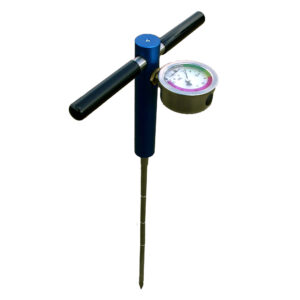
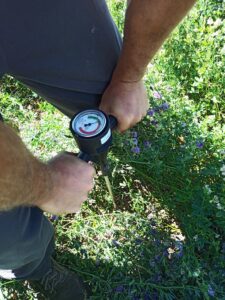
Below is an example of penetrometer test results from three different locations on June 4, 2023, which show a typical response observed throughout the testing period. As demonstrated, measurements above the Keyline tend to have greater levels of compaction as compared to in the rip. It should be noted that biological life is greatly reduced at 300 pounds per square inch and above. The measurements obtained within the rip indicate that there is an opportunity for biological life to flourish. This, coupled with observations of improved water infiltration fosters an environment that is necessary for soil biology.
Baseline forage production within the project area was determined by clipping. The baseline forage production in 2022 was approximately 2,700 lbs/acre. The direct impact of Keyline cultivation and bale grazing resulted in twice the amount of forage production as compared to areas that were indirectly impacted in 2023, see table below. When compared to the traditionally managed system, forage production was 64% and 28% greater in the direct and indirect areas, respectively.
| Year | Keylines + Bale Grazing - Direct Impact | Keylines + Bale Grazing - Indirect Impact |
Perennial that is hayed annually, with a cover cropping history ( 2016-2018: cover crop; perennial planting: 2019) |
| 2023 | 5,400 lbs/acre | 2,700 lbs/acre | 1,950 lbs/acre |
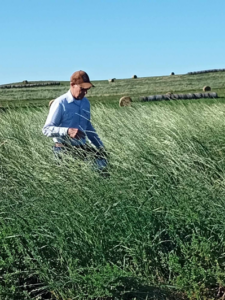
Prior to bale grazing during the winter of 2022, cows had an average body condition score of 5.5 which means they had a good overall appearance. On palpation, fat cover over ribs feels spongy and areas on either side of tail head have palpable fat cover. Sheep body condition was scored at 3 which means that vertical processes are smooth and rounded. The bone is only felt with pressure. The horizontal processes are also smooth and well covered; hard pressure is required with the fingers to find the ends. The loin muscle is full and with a moderate fat cover. Multi-species bale grazing began on December 12, 2022 and ended on May 30, 2022. The cows actually calved in the project area, while continuing to bale graze. Prior to calving, the average body condition score was 4.5 which means that some cows appeared thin, with ribs somewhat visible and backbone showing. Muscle tissue was not depleted through the shoulders or hindquarters. Other cows were described as moderate to thin. The decline in body condition is attributed to the record breaking snowfall received during the winter.
The sheep were actually pulled from bale grazing halfway through the winter. Although supplementation was provided to help them maintain their condition, the sheep preferred to stay with the cows in the project area during winter storms. They would not come in on their own, even when additional windbreak and supplementation was provided. As a result, they crowded together with the cows and some ended up with broken legs. To prevent any further injury or loss of condition, it was decided to pull them from bale grazing and feed them in the corral until the weather conditions improved.
Prior to bale grazing during the winter of 2023, cows had an average body condition score of 5 which means that most were able to rebound from the harsh winter. Again, sheep body condition was scored at a 3. Body condition will continue to be monitored and a final report will be made upon removal from bale grazing. Currently, the winter has been very mild with little to no snowfall. The livestock have been able to graze forage regrowth while bale grazing. It has been observed that both the cows and sheep prefer to graze what they can before eating hay.
For more information on body condition scores of beef cattle:<https://beef.unl.edu/learning/condition1a.shtml>
For more information on body condition scores of sheep: <https://extension.sdstate.edu/sites/default/files/2021-07/MC-02221.pdf>
While these initial results are interesting, we look forward to collecting soil samples in the spring of 2024 to better evaluate change over time. We also plan to make more observations regarding runoff and will continue to track time and money spent to implement bale grazing and Keyline cultivation versus other management strategies. As we work through the final stages of the project, a self assessment will be performed to evaluate one's own satisfaction with the project.
Educational & Outreach Activities
Participation Summary:
Throughout the project period, we participated in and led a number of outreach activities to share about the project and what we are learning. Activities include but are not limited to social media, field day handouts, newsletter articles, conference presentations, mail box tours, podcasts, TV interviews and numerous consultations. While conducting many of these activities, we share about the project and personally encourage people to participate in the mail box tour and/or give us a call to visit or schedule an in-person tour.
The project will be documented through various social media platforms like Facebook and YouTube. Photos, videos and data results will be shared throughout duration of the project period in hopes of providing an educational experience to others. While some producers directly approach us about what we are doing, many of them want to quietly observe and drive by the project area. We hope that social media platforms will provide anonymous viewing for those that are apprehensive about approaching us directly. We anticipate that social media posts will be viewed by 1000+ people per post. However, we are always open to and excited about visiting with local and regional producers.
In the spring of 2022, Drew and I were interviewed by NDSU Extension Educators for the Agriculture Applied podcast. Extension educators visit with producers and NDSU Extension Specialists about innovative ideas and reflect on generational changes which can help to create a better tomorrow. It was reported that approximately 200 people downloaded the episode for listening.
During the fall of 2022, a field day handout was developed and shared at Grant County Ag Day. We also gave a short talk about the Farmer Rancher SARE program and provided testimonial about our project. Approximately 150 people participated in the program.
We also wrote and published an article through the North Dakota State University Central Grasslands Research Extension Center Newsletter which goes out to 1000+ producers in the region.
Karl Hoppe, the North Dakota State Coordinator for SARE, toured the project area during the fall of 2022 and wrote a story that was published by North Dakota State University. The story was reviewed by nearly 1000 people in the region. At the time of Karl's visit, a film crew associated with PBS and America's Heartland came to capture footage that will be used in promotional materials for SARE. By combining PBS and RFD-TV viewership, America's Heartland reaches more than 1 million person impressions per episode. We have not included those numbers here, to prevent skewing SARE report data.
The episode can be viewed here: https://www.youtube.com/watch?v=A0S92CUOwM4
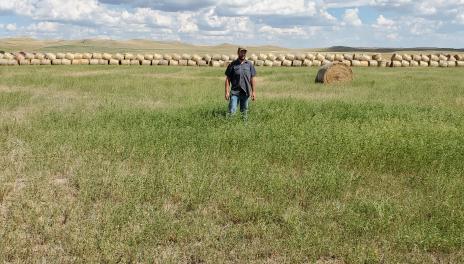
https://www.ndsu.edu/agriculture/ag-hub/impact-stories/bale-grazing-next-year
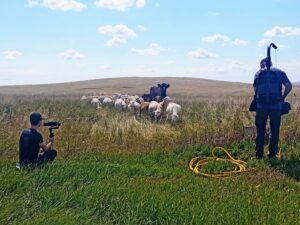
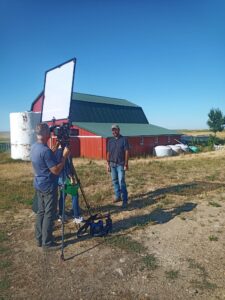
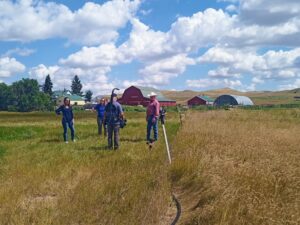
Karl Hoppe also published an article in the Jamestown Sun which highlighted our SARE grant and encouraged other producers to apply to the Farmer Rancher grant program. Approximately 1000 people subscribe to the Jamestown Sun.
https://www.jamestownsun.com/business/sare-farmer-rancher-grant-proposals-due-dec-1
In January of 2023, we talked about our bale grazing research at the Northern Plains Food and Farming Conference. Approximately 50 people attended our presentation and 547 have viewed the online recording. We also networked and learned from other participants in the conference. The presentation can be viewed here: https://www.youtube.com/watch?v=K6Vtz3xX-ZA&t=712s
The Lemmon Farm and Home Show took place in March of 2023 and was attended by approximately 200 people in the community. I had a SARE booth and encouraged attendees to consider the various grant opportunities. I updated our project handouts and shared materials at the tradeshow: Mailbox Handout; Temporary Fence Materials
Also during March of 2023, we hosted a group from Canada and Kazakhstan who wanted to learn more about winter bale grazing and how it may or may not work within their respective regions. The group of 12 spent a day at the ranch, touring through project areas and observing other practices. They asked a lot of questions and we continue to be in contact today as we work together to address resource concerns.



During the fall of 2023, we developed a driving/walking tour of the project area that was/is available year round. A mail box is on-site with information about the project: Mailbox Handout; Temporary Fence Materials
People can participate in the mailbox tour on their own or they can reach out to us if interested in a more formal tour. While it is hard to estimate the number of people that have participated in the mailbox tour, we have used approximately 20 handouts. At outreach events, we promote and encourage producers to participate in the tour. We also know that many people drive by to observe the project, but do not stop at the mailbox to get materials or to get a closer view of the project. Most want to remain anonymous, but we have found that the mailbox tour and/or the opportunity for people to simply drive by the project area has been one of the more successful outreach efforts. It is interesting to learn about who is paying attention to what we do. We don't usually hear about it directly, but rather observe that they have implemented their own bale grazing efforts, etc.
In the fall of 2023, Drew spoke about our bale grazing efforts at a Coffee Talk. Approximately 25 people attended.
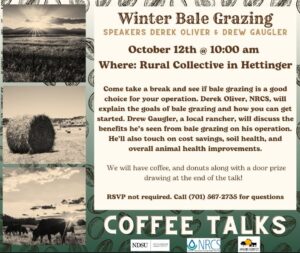
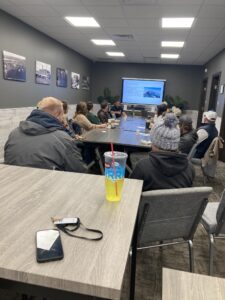
In December of 2023, Drew and I spoke at the 8th annual Soil Revolution Conference in Boulder, Colorado. The presentation will be made available online in January 2024 and can be found at: https://soilrev.org
Approximately 200 people attended in person and the conference was also live-streamed.
A few years ago, Drew and I were interviewed for a film put together by Janna Bystrykh from the Netherlands. She pulled interviews and drone footage over Highway 83 into a retrospective of what is happening on the land along the 100th Meridian of the Great Plains. It has been in a few film screenings in Europe, such as Rotterdam, Groningen, and Amsterdam, but has never been in the United States. However, the USDA-ARS Northern Great Plains showed the film at the Farming and Ranching for the Bottom Line event in Bismarck, North Dakota on February 22, 2024. I participated in a panel discussion post-viewing. It is hard to project the number of people that have viewed these film screenings. Here is a link to the web page about the film: https://bystrykh.com/Great-Pla-ns
Learning Outcomes
One of the major lessons learned from this project is that building soil organic matter is a slow process. However, through bale grazing and Keyline cultivation, we were able to build soil carbon quickly . In fact, total soil carbon increased by as much as 92% and 76% at 0-6" and 6-24", respectively. The percentage increase of total soil carbon at 0-6" and 6-24" was not always consistent. We anticipated that the opportunity to improve soil health would occur more quickly at the subsoil level. Monitoring over a longer period of time is necessary to determine of the soil nutrient response is greater at the surface or subsoil level. Increases in soil respiration were detected and indicate that the cool, moist, dark environment of Keylines promotes microbial activity and will result in an increase of soil organic matter.
The result of bale grazing and Keyline cultivation to promote soil carbon has resulted in an increase in plant productivity across the operation. The increase in productivity has occurred in both historically productive and troublesome areas. It has also promoted resiliency during years of drought or other extenuating circumstances.
The advantages include:
- Increase in water infiltration
- Carbon capture
- Increase in soil microbial activity and respiration
- Increase in plant productivity and resiliency
The disadvantages include:
- Time required to survey and install Keylines
Bale grazing can be used as a management tool on a large scale. The use of Keyline cultivation has been successful as a tool for rehabilitation in problem areas. More work is needed to determine its usefulness on a large scale, including the frequency and economics of Keyline cultivation.
Project Outcomes
We have had a few projects funded by NC-SARE that have had a unique focus on bale grazing with the goal of improving soil health. While folks may not be particularly interested in incorporating multi-species (the focus of the second project) or using Keyline cultivation (the focus of the third project) to enhance soil health benefits, many are curious about the success we have had with bale grazing. As a result, numerous folks have adopted bale grazing and are able to make it fit the needs and goals of their operation.
Like any project that we have conducted through the Farmer Rancher Grant Program, it has opened up more questions and peaked our curiosity. Specifically, we would like to learn about the efficacy of Keyline cultivation on a large-scale basis and be able to understand the frequency at which cultivation may be required. With regards to bale grazing itself, we are curious about how different sizes and shapes of bales may influence feed efficiency. We are also curious about the response of productive versus unproductive areas and where we can create the biggest impact. Or, where the greatest opportunity for positive change may be likely to occur. Similarly, will notable differences in soil nutrient response occur over time at 0-6" versus 6-24" within Keylines.
